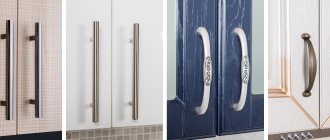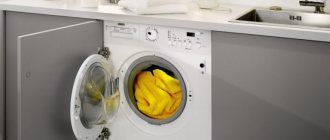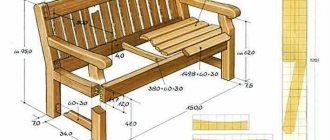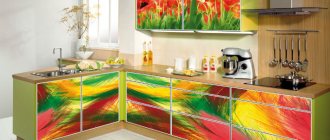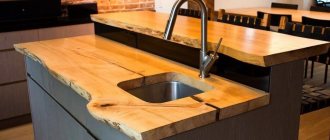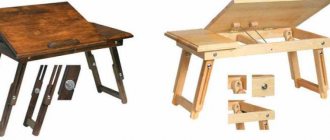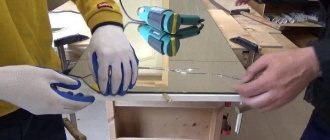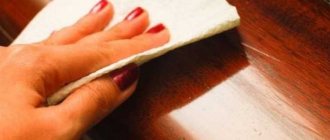Holes
Repairing holes on the surface is quite easy, because most often they are not too deep.
They arise from sharp blows with a heavy object, for example, with a hammer when beating meat.
First you need to clean the hole with a file to make the wax stick better. Then properly degrease the top of the hole with solvent or alcohol.
A tabletop made of chipboard or solid wood can be restored with your own hands.
After the degreaser has dried, heat the wax until soft. To make the final stage of work easier, it is recommended to immediately select a filler that matches the color of the material.
We seal the hole with wax, leaving a little of this material on the surface of the countertop.
After hardening, use a plastic spatula to remove excess from the surface.
We polish the repair area well with a felt rag. If the texture of the wax after polishing matches the rest of the surface, we complete the work.
If additional coating with furniture varnish is necessary, we carry out such manipulations. Some time after the varnish has hardened (16-24 hours), we polish it again with felt.
The tabletop is covered with a layer of varnish to secure the result.
How to repair an artificial stone countertop?
Artificial stone products look great in a modern kitchen interior. Artificial stone retains its attractive appearance for a long time. However, despite their strength, countertops made of artificial stone require careful care, since the surface can easily be damaged by concentrated household chemicals, mechanical impact or hot objects.
Repairing the countertop should be done immediately after a defect is discovered, since the slightest damage over time can result in labor-intensive and expensive repairs.
Important! The maintainability of artificial stone products is high, so there is a chance to restore their original appearance.
Fighting stains
If hard-to-remove stains appear on the surface, you can try to eliminate them with a special polyester composition. Sanding the table top with sandpaper of various grain sizes - from P120 to P400 - helps a lot. After sanding, the problem area is polished with felt.
How to eliminate chips?
A chip, even a significant one, can be eliminated with a special composition based on polyester resin. Repairs are carried out in this order:
- Degrease and clean the countertop around the damaged area.
- Seal the chip with special resin.
- After complete drying (18-20 hours), sand the surface of the tabletop with a diamond-filled abrasive and polish with felt.
In most cases, restoring such products is a complex process, and it is better to contact a specialist.
And also read a selection of articles:
- How to update a countertop with your own hands.
- DIY tile countertop.
- How to glue table top edge with glue.
Scuffs
Scuffing is one of the easiest defects to eliminate. The depth of the abrasion is small, just rub the damaged area with a furniture felt-tip pen. You should not work it directly on the surface. It is recommended to first paint a soft cloth, such as silk, with it. And then use this rag to thoroughly treat the abraded area.
Before you begin repairing the product, you should conduct a small diagnostic and assess the nature of the damage.
In this simple way you can deal with shallow abrasions. If the size of the defect is too large, we paint the surface with a felt-tip pen of the appropriate shade, and then polish the resulting area with a piece of cloth.
Using this technique, it is possible to blur the boundaries of processing with new paint and smooth them out visually.
If it is necessary to restore a varnished surface, before painting, use fine sandpaper to thoroughly clean the area of wear, degrease it, and only then paint. After the furniture marker has dried, we coat the work area with varnish, which we also polish 16-18 hours after application.
To avoid new scratches, it is better to cover the surface with a protective compound or transparent film.
Repairing kitchen countertops: options and practical tips
When choosing a suitable top model, follow the basic selection criteria. They will affect the ease and size of the budget when renovating kitchen countertops in the future:
- Strength level. To do this, the working surface must be equipped with a shockproof coating. Then repairing kitchen countertops at home can be done in the shortest possible time by replacing the surface.
- Moisture resistant. The kitchen is a place where fats, water stains, and drops accumulate, so protection of MDF, laminated chipboard, and veneer is mandatory.
- Attractive design. The range of coatings for kitchen countertops is so wide that you can choose the right option for yourself. Many are inclined towards painted or film MDF. In this case, you will be able to experiment not only with color, but also with texture (imitation wood, brick, metal, 3D printing, aging effect, metallic, etc.).
We carry out restoration of kitchen countertops, taking into account the design features of the kitchen unit and the personal wishes of the customer.
Among the numerous collections, the most popular today for repairing kitchen countertops are:
- Models made of laminated chipboard. Reliable, they show excellent performance characteristics. The “trump card” of such surfaces is considered to be a comfortable price and ease of maintenance. With this material, restoration of a kitchen apron and countertop will be accessible to everyone.
- Natural stone tops are a “counterbalance” to the previous option. Elite models are expensive. They are characterized by elegant shapes, fit to any size, and a sufficient degree of strength. They are moisture-resistant, tolerate temperature changes, and are not able to absorb foreign odors. And structures made of artificial stone are presented in an even wider color palette than their “solid competitor”.
- For aluminum profiles, at the time of restoration of the kitchen countertop, an unusual texture is selected (the effect of dullness, gloss and other decor). Durability, a reliable layer against the adhesion of dirt, stains, and grease - this is the best that an aluminum and stainless steel structure offers for repairs.
Chips
Chips occur quite often, because in the kitchen there are a lot of dishes and cutlery with sharp edges.
To remove the chip you will need wax. Here, too, the main recommendation is to choose a material that matches the color of the countertop, because painting the wax base can be quite problematic.
Such damage to the edges of the tabletop will require even more labor-intensive repairs.
We cut it off or thoroughly sand the chipped area, melt the wax and apply it to the problem area. We wait for it to dry completely, polish it - and you’re done.
The molten composition is applied to the damaged area and given the desired shape.
If you need to tint the repair area or varnish it, we complete the restoration process with such work
After the wax has hardened, the excess is cut off and sanded.
Scratches
Removing scratches from a surface is as easy as removing abrasions, and maybe even easier. Before starting work, degrease the surface. If the scratch is shallow, it can be quite simply rubbed with a piece of wax (often there is no need to even melt it).
If the scratches are deep, you can use soft wax.
If the scratch depth is more than 3 mm, we perform preliminary cleaning of the surface from dirt for better adhesion of the wax.
Then we polish the work area with a piece of felt. If necessary, tint with furniture varnish. It is recommended to use ear sticks for small scratches; for larger scratches you will need a brush of the appropriate width.
Finally, the tabletop should be coated with colorless varnish.
Note! If there are several deep scratches nearby, it is recommended to completely remove the surface layer of the countertop in this area. This will allow you to avoid repeated damage to the integrity of the treatment area due to exposure to moisture - even with the most painstaking work, microcracks will certainly remain and grow over time.
Wax is applied to the scratch using a rubberized spatula.
Where to start repairing countertops
Regardless of the material, countertop repairs begin with a thorough inspection. Most often, in addition to one main, most noticeable defect, several more are found: scratches, small chips, deformed corners, etc. In most cases, it is necessary to separate the tabletop from the base, if necessary, completely remove the damaged areas, clean and degrease the tabletop.
Regardless of the material, countertop repairs begin with a thorough inspection.
See also: Do-it-yourself refilling of the refrigerator with freon: step-by-step instructions, tips and tricks
Cracks
Cracks on the surface of the countertop are the most common reason for its complete replacement. As the material most susceptible to negative influences, the top layer will certainly become unusable after some time. And the thinner and cheaper the material of the top layer of the countertop, the sooner it will begin to become covered with cracks.
If even small cracks appear on the countertop, urgent repairs are required - otherwise the crack may grow larger, and then the panel will no longer be repairable.
Before you begin work on restoring the countertop from cracks, it is necessary, in principle, to assess the feasibility of such work.
A wide crack in the top layer across the entire tabletop makes repair impractical. Even the most painstaking work will inevitably crack again after a while.
Glue is taken into the syringe and the crack is filled along the entire length. If it is very thin, a needle is put on the syringe for more precise coating.
If it is shallow and small, we proceed according to the standard scenario.
We clean, degrease, apply wax, polish. Additional painting and varnishing as needed.
It is recommended to immediately apply wax of a suitable shade; due to the large size of the cracks, even professionals are not always able to restore the uniform color of the surface.
A day later (after the glue has dried), the restored area is painted over in a suitable tone.
Wetting the tabletop
Soaking is another fairly common case of tabletop damage. The reason for its appearance is prolonged exposure to moisture, so most often the edges are subject to such defects.
If the wood chip layer is swollen under the laminated film, it will take some effort to correct the situation.
Soaking immediately attracts attention, so many people strive to eliminate this problem as quickly as possible.
Note! Fixing this problem often requires complete removal of the countertop.
First, you should thoroughly dry the countertop. Then mechanical cleaning of the soaking area from rotten parts is carried out.
The restored area is covered with bars and clamped with a clamp. The product is left in this position for 24 hours until the glue dries completely.
After this, furniture glue mixed with sawdust is placed into the resulting cavity; you can even use the remains from the previous step.
Note! Now it is important to press the glued layers as best as possible on the wet side.
Leave the tabletop under load for at least 24 hours. The more pressure the load puts on the repair site, the smoother and more uniform the result will be.
Treating the ends with water-repellent sealant or silicone compounds will help prevent swelling of the wood-based base under the laminated film.
After the glue has dried, install the tabletop in place. It is recommended to treat the open and unprotected side surfaces of the tabletop with silicone sealant; it will protect against repeated damage.
Restoration of a chipboard tabletop
Getting wet often causes the surface to swell. This defect can be easily corrected with glue.
A small delaminated fragment or swelling after soaking can be dried well with a hairdryer, soaked in glue and placed in a vice. After drying, remove excess chipboard by sanding and laminate with sealant - this is the easiest repair.
A burnt countertop is the most difficult to repair; most often you have to call in specialists.
Important! If an area is burned from exposure to a hot object, it is difficult to restore the design or patch a hole in the laminate. You will have to select a material with a similar pattern and make a complex insert of the fragment, placing it on glue.
There are other ways to independently repair areas damaged by water penetration into the wood-chip layer.
The easiest way is to do preventative repairs. In those areas where the trim has peeled off or there is a small chip, it needs to be treated with a sealant or protective varnish to prevent moisture from penetrating into the sawdust base.
To avoid further problems with the countertop, it is best to coat the surface with a sealing varnish or other means.
To effectively repair operational defects, you need to complete the following steps:
- clean the surface from greasy dirt;
- remove protruding sawdust with sandpaper or a file;
- dry the area with a hot stream (hairdryer);
- fill the crack with a mixture of construction PVA and fine sawdust;
- place the surface under a press or in a vice;
- a day later, clean the area to be restored;
- Treat the seams with silicone or other sealant and secure with a plastic, aluminum or wooden strip.
Do not use sandpaper if there is a laminated or varnish coating.
Deep scratches on the countertop can be removed by sanding with sandpaper - first coarse, then fine grit. Next, rub in with a felt pad. But this option is not suitable if a pattern is applied to the laminated surface.
Restoration with hard furniture wax
This substance is intended to eliminate small marks from mechanical damage. They are inevitable when the table surface is subjected to excessive loads, as well as as a result of the fall of heavy sharp objects.
You can use a utility knife to apply wax to the damaged areas, then melt it with a lighter.
The palette of this material is not as wide as we would like. But it guarantees a high degree of protection (moisture resistance) of the wood-chip base. Hard wax makes it possible to eliminate chips, dents and scratches.
The color palette of hard wax is not so wide, so if you have a countertop of an unusual color, it is worth looking for another repair method.
Before application, it must be melted, for example, from a candle or a lighter flame. After application, it is allowed to cool and the process is repeated. After filling the defect, sagging and protruding fragments are removed by grinding with a sharp knife - the surface looks laminated.
Soft wax for surface restoration
Soft types of wax are used to combat minor defects.
A simple, natural-based material that is good for filling small cracks and dents. But most often wax is used to fill holes from nails, screws or self-tapping screws.
After waxing, the furniture must be polished with a napkin or felt.
Soft wax is injected with the narrow end of a spatula or knife. The wax is slightly warmed up and, after flowing, polished with felt. It is also suitable for masking defects in natural wood; the texture underneath is drawn with a felt-tip pen or marker of a suitable shade.
Furniture touch
Using this material it is possible to disguise minor scratches and abrasions. A stroke is a pigment, it is pre-shaken before application and after application in 2-3 layers, it is allowed to dry thoroughly for 5-10 minutes. Excess is removed with a dry cotton napkin.
Thanks to the wide color palette and the possibility of tinting, you can choose any shade.
This is one of the easiest ways to eliminate damage to a countertop. However, it is not necessary to apply it several times if the restoration was successful the first time.
Burns
Burn-through occurs when the surface is exposed to too hot dishes. Before you restore a kitchen countertop made of laminated chipboard, you need to get rid of the visible burn area. We work with sandpaper or a file, as necessary.
If the protective laminated layer is exposed to high temperatures, it will leave an unsightly burn mark.
And then we carry out the same algorithm as for a scratch - fill it with wax, sand it, paint it or varnish it.
By following our simple tips, you can easily, quickly, and most importantly, economically bring your countertop to its original form.
The best option is tabletops, the edging of which is made of aluminum tape.
Features of restoration of a kitchen countertop made of laminated chipboard
It is the kitchen countertop that is exposed to negative influences: moisture, household chemicals, high temperature, etc.
As a result, over time it begins to deform. One of the most important surfaces for cutting food and cooking is subject to the greatest load and quickly loses its original appearance. Delamination of the base occurs due to daily use of a humid environment; the surface often comes close to the stove and overheats. The laminated layer is often cleaned with abrasives. Because of this, there is often a need for restoration.
Defects on the countertop may vary. The type of restoration will depend on their type.
The main operational defects of kitchen countertops:
- corners and some other parts are deformed;
- cracks on the laminated surface;
- swelling and peeling;
- broken fragments along the edges;
- scratches and bald spots on the decorative layer;
- traces of mechanical damage.
In order for the repair to be correct, you need to know exactly the composition of the countertop, since they usually include a combination of different materials.
Helpful advice! Each defect is eliminated in its own way. Before you repair a chipboard countertop yourself, check what each layer consists of so that all work can be completed quickly and efficiently.
- A tabletop made of natural wood has its advantages and disadvantages. The product is easily saturated with wet and greasy environments, leaving stains. It may crack if it dries out. But such a surface is not afraid of hot pots and abrasive products for cleaning kitchen furniture. Varnished wood is better protected from food contamination, but hot objects leave circles, stains and cloudiness on it.
- MDF has a number of aesthetic advantages, but is often subject to the destructive effects of moisture and overheating, hence the problems of deformation. Film coating is not able to protect kitchen furniture if it is handled carelessly - hot objects are placed, meat and vegetables are cut, nuts are cracked.
- Laminated chipboard is well protected, but if there is the slightest detachment of the protective layer, penetrating water quickly leads to swelling of the base. The quality of laminated chipboard in terms of performance characteristics is slightly inferior to MDF. Both materials are more difficult to restore than natural wood.
- Decorative plywood is less often used for kitchen countertops; more often it is used to make furniture doors. Repairing defects is much more difficult due to the characteristic longitudinal-transverse layering of wood fibers.
